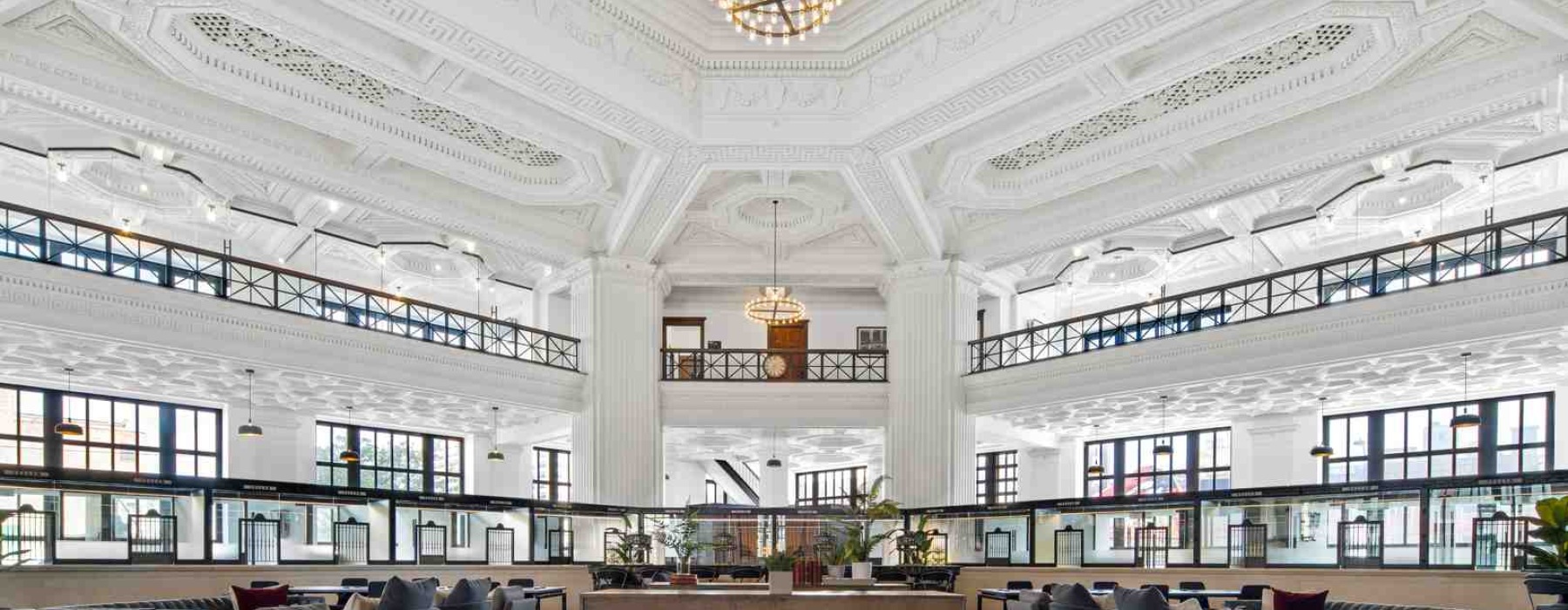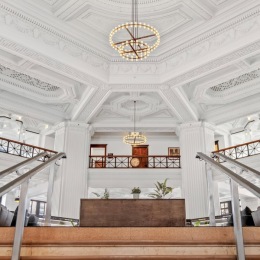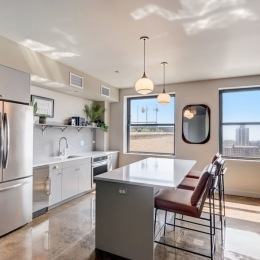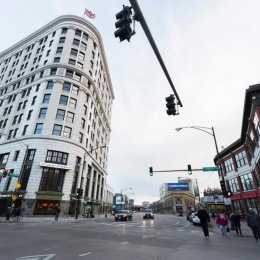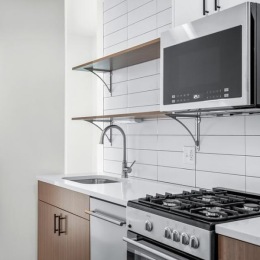Why Chicago's Historic Properties Are Worth Your Lease
Leasing historic properties in chicago offers a unique blend of architectural character, community culture, and environmental benefits that modern buildings simply can't match. From converted bank buildings with soaring ceilings to former schools transformed into luxury lofts, Chicago's landmark properties provide distinctive living and working spaces steeped in local heritage.
Key Benefits of Historic Property Leasing:
- Architectural Character - Original hardwood floors, exposed brick walls, ornate lobbies, and 9-20 foot ceilings
- Community Connection - Smaller buildings foster tight-knit neighborhoods with established cultural scenes
- Environmental Impact - Adaptive reuse reduces demolition waste and preserves embodied energy
- Prime Locations - Historic districts typically offer walkable access to dining, parks, and transit
- Sound Quality - Solid brick and plaster construction provides superior soundproofing versus modern drywall
Chicago is home to more than 300 designated landmark districts and over 10,000 properties listed in the Chicago Historic Resources Survey. The city's adaptive reuse projects range from intimate residential conversions to massive developments like the Old Post Office - one of the nation's largest historic redevelopments at 2.5 million square feet.
Historic buildings often feature fewer units than modern complexes, creating more personal communities where tenants can engage with preservation boards and influence building decisions. Many properties blend original details like marble entryways and wood trim with contemporary conveniences including online rent payment systems and 24/7 maintenance services.
The financial landscape also favors historic preservation through programs like the Class L Property Tax Incentive, which can reduce assessments to as low as 10% for qualifying buildings, and combined federal and state tax credits offering up to 45% in rehabilitation incentives.

Why Choose a Landmark Lease? Unique Benefits & Lifestyle Perks
When you walk into a historic building, you immediately feel the difference. Leasing historic properties in chicago means stepping into spaces where every detail tells a story - from the hand-carved woodwork to the soaring 13 to 19-foot ceilings that make even a studio apartment feel grand.
These aren't just tall ceilings for show. Those dramatic heights create bright, airy spaces that flood with natural light through carefully restored windows. The original hardwood floors beneath your feet have aged beautifully over decades, developing a character and patina that new construction simply can't replicate.
But it's not just about looks. The solid brick and plaster construction of historic buildings offers something modern apartments often lack: real quiet. While your friends in newer buildings deal with paper-thin walls and noisy neighbors, you'll enjoy the superior soundproofing that comes from construction methods built to last.
Historic neighborhoods have another advantage - they've had time to develop character. You're not moving into a brand-new development surrounded by empty lots. Instead, you'll find yourself within walking distance of established parks, local restaurants, cultural attractions, and reliable public transportation that's been serving the community for years.
There's also the environmental angle to consider. When you choose a historic property, you're supporting adaptive reuse that preserves the energy and materials already invested in these buildings.
The Allure of Legacy Living – leasing historic properties in chicago
Every historic building has a story, and Chicago's architectural heritage includes some pretty impressive chapters. The city showcases works by legendary designers like Louis Sullivan, Frank Lloyd Wright, and Henry Hobson Richardson - names that still influence modern architecture today.
Living in these spaces means being surrounded by authentic craftsmanship that modern construction rarely matches. Think hand-carved wood trim, terrazzo floors, ornate plasterwork, and custom millwork created by artisans who took genuine pride in their work.
Former bank buildings - like many of Chicago's most striking conversions - often retain their original vault doors, marble counters, and elaborate ceiling work. These aren't decorative replicas; they're the real deal. Converted schools might preserve original chalkboards and distinctive window configurations, while industrial conversions showcase exposed brick, heavy timber framing, and soaring spaces originally designed for manufacturing.
Community & Culture Payoffs
Here's something you might not expect: historic buildings typically house fewer units than modern apartment complexes. This creates a more intimate community where you actually get to know your neighbors instead of passing faces in endless hallways.
This smaller scale means you can have a real voice in your building's future. Many historic properties allow tenants to participate in preservation decisions and building improvements. You're not just renting space - you're becoming part of the building's ongoing story.
Historic neighborhoods are magnets for cultural activities. From historic home tours to neighborhood festivals, these established communities offer cultural events and preservation activities that bring residents together. The tourism appeal of landmark districts also supports local businesses and cultural institutions, creating vibrant neighborhoods that benefit everyone who lives there.
Mapping Chicago's Historic Leasing Hotspots
Leasing historic properties in chicago means exploring neighborhoods where each area tells its own story. The city's landmark districts spread across different communities, each offering unique character and lifestyle benefits that match different needs and preferences.
River North stands out for its converted warehouses and former commercial buildings that rose from the ashes after the Great Chicago Fire. These sturdy brick structures now house modern apartments with original architectural details. The neighborhood puts you steps away from downtown jobs and some of the city's best restaurants and nightlife.
Old Town Triangle offers a more intimate historic experience with tree-lined streets and well-preserved buildings. The area combines residential charm with cultural attractions, making it perfect for those who want historic character without sacrificing modern conveniences.
Uptown brings together converted schools, former civic buildings, and historic theaters in one vibrant neighborhood. The area's entertainment heritage creates a lively cultural scene, while the mix of building types provides diverse rental options for different budgets and space needs.
Moving south, the South Loop and Prairie District showcase former industrial buildings transformed into spacious lofts. These neighborhoods put you near Grant Park, world-class museums, and multiple transit lines, making them ideal for professionals who want both culture and convenience.
Pilsen and Bronzeville represent Chicago's emerging historic rental markets. These neighborhoods maintain strong cultural identities while offering more affordable entry points into landmark living.
Top Building Types to Expect
Loft conversions dominate Chicago's historic rental market, changing former factories and warehouses into dramatic living spaces. These buildings typically rise 2-7 stories with thick brick walls, oversized windows, and ceiling heights that soar from 12 to 20 feet.
Former bank buildings offer some of the most unique rental opportunities in the city. Original marble lobbies welcome you home, while ornate ceiling work and period lighting create an atmosphere of timeless elegance. Some units even incorporate original vault spaces as distinctive bedroom or office areas.
Converted schools provide surprisingly spacious apartments with wide hallways and distinctive window configurations that flood units with natural light. Many retain charming details like original chalkboards and built-in cabinetry.
Historic greystones and vintage apartment buildings from the early-to-mid 20th century offer classic residential layouts with period charm. Think hardwood floors that have aged to perfection, built-in hutches, and decorative plasterwork that modern buildings simply can't replicate.
leasing historic properties in chicago: Neighborhood Matchmaking
Finding your perfect historic neighborhood starts with understanding how you actually live your daily life. If you commute downtown, many historic districts offer excellent public transit connections, though parking can be limited compared to newer developments.
Consider what makes a neighborhood feel like home to you. Historic districts often feature walkable commercial strips with local coffee shops, bookstores, and restaurants that create genuine community character. These aren't chain-heavy areas - you'll find businesses that have been serving the neighborhood for decades alongside exciting new ventures.
Leasing Historic Properties in Chicago: Process, Rules & Preservation 101
Leasing historic properties in chicago comes with unique considerations that go beyond your typical apartment hunt. While the process might seem more complex at first, understanding these special requirements helps you steer everything smoothly and enjoy your piece of Chicago's architectural heritage.
Historic buildings with Chicago Landmark status require permit review for any changes - even small ones. The Commission on Chicago Landmarks carefully evaluates proposed alterations to ensure they preserve the building's character. This might affect tenant improvement projects or routine maintenance, but it also protects the unique features that drew you to the property in the first place.
Insurance for historic properties often differs from standard coverage due to specialized restoration needs and replacement costs. Some buildings require specific coverage for historic materials and unique restoration techniques that modern buildings don't need.
Accessibility requirements still apply to historic buildings, though accommodations may be made for structural limitations. Understanding these requirements helps set realistic expectations for building access and potential modifications.
| Historic Property Lease Considerations | Modern Property Comparison |
|---|---|
| Permit review for alterations | Standard tenant improvements |
| Preservation material requirements | Flexible renovation materials |
| Limited parking availability | Dedicated parking structures |
| Potential utility cost variations | Standardized utility systems |
| Heritage board consultation | Property management decisions |
Step-by-Step Lease Journey – leasing historic properties in chicago
Your property research phase starts with identifying buildings that match both your space needs and your taste for historic character. Check the Chicago Historic Resources Survey to verify landmark status and understand any preservation restrictions that might affect your daily life as a tenant.
The application and screening process follows standard rental procedures but may include extra documentation about how you plan to use the space and any modifications you're considering. Some historic properties have specific tenant selection criteria that relate to their preservation goals.
Lease negotiation becomes especially important when it comes to maintenance responsibilities. You'll want to clearly understand who handles repairs to original architectural elements versus modern building systems. This clarity prevents confusion down the road.
Your pre-move inspection deserves extra attention to historic features and their current condition. Document any existing issues with original materials, windows, flooring, or architectural details. This protects both you and your landlord from future disputes about who caused what damage.
Navigating Preservation Requirements & Amenities Trade-Offs
Window modifications in landmark buildings typically require approval from preservation authorities. Original windows might need restoration rather than replacement, which can affect energy efficiency and maintenance costs.
HVAC system upgrades must balance your comfort with preservation of historic spaces and building facades. Many buildings use creative solutions like mini-split systems to avoid major structural changes while still keeping you comfortable year-round.
Pet policies in historic buildings sometimes consider the impact on original flooring, landscaping, or architectural features. Some properties may have restrictions to protect historic materials or maintain the building's character - though many welcome pets with proper precautions.
Elevator installations or upgrades in historic buildings often need specialized engineering to preserve structural integrity and architectural character while meeting modern accessibility standards.
Tax Breaks, Grants & Dollars-and-Sense Incentives
Chicago's financial incentives for historic properties make leasing historic properties in chicago surprisingly affordable. These programs create real savings that often get passed down to tenants through competitive rent pricing and better building amenities.
The Class L Property Tax Incentive delivers the biggest impact for landmark buildings. Property assessments drop to just 10% for the first ten years, then gradually increase to 15% in year eleven and 20% in year twelve. That's a massive reduction from standard rates, requiring owners to invest at least 50% of the building's value in approved restoration work.
Federal Historic Tax Credits sweeten the deal even more. Property owners can claim 20% credits on qualified rehabilitation expenses for income-producing historic buildings. Illinois adds its own state credits of up to 25%, bringing total incentives to an impressive 45% of rehabilitation costs. These substantial savings often translate into better building maintenance, upgraded amenities, and more competitive rental rates.
The Landmarks Illinois Reinvestment Program steps in when traditional financing falls short. This program offers loans up to $500,000 for preservation projects in historically under-resourced neighborhoods. The flexible terms help fund adaptive reuse projects that create new rental opportunities in areas that might otherwise struggle to attract investment.
Chicago's Adopt-A-Landmark Fund channels downtown construction fees into restoration grants for landmark buildings. Recent grants totaling over $8 million support restoration work valued at more than $150 million. Individual projects receive anywhere from $125,000 to over $2 million, funding everything from roof repairs to complete facade restorations.
The Illinois Property Tax Assessment Freeze program provides 8-year assessment freezes plus 4-year phase-outs for eligible historic renovations. While this primarily benefits initial owner-occupant purchasers, it influences overall rental market dynamics by encouraging more historic preservation projects.
These incentives create a ripple effect throughout Chicago's historic rental market. Buildings that receive tax breaks and restoration funding often invest in modern amenities while preserving historic character. Scientific research on adaptive reuse benefits shows that these programs successfully balance preservation goals with economic viability.

Financial Checklist for Tenants & Owners
Energy costs in historic buildings deserve careful attention. Older buildings sometimes have higher heating and cooling expenses due to less efficient building envelopes. However, solid brick and plaster construction often provides natural temperature regulation that helps offset some utility costs.
Maintenance expenses require planning for specialized materials and restoration techniques. Historic features like original hardwood floors, plaster walls, and vintage windows may cost more to maintain than modern equivalents. The trade-off is preserving character and building value that modern materials simply can't replicate.
Insurance considerations may include higher replacement costs for historic materials and specialized restoration requirements. Some properties need coverage for restoration techniques and materials not typically used in modern construction.
The financial landscape strongly favors historic preservation through these combined incentive programs. Property owners who take advantage of available tax credits and grants often reinvest those savings into building improvements and competitive rental pricing.
Challenges & Practical Solutions
Let's be honest - leasing historic properties in chicago isn't always a walk in the park. These beautiful buildings come with their own set of quirks and challenges that you won't find in brand-new developments. But here's the thing: every challenge has a solution, and knowing what to expect makes all the difference.
Higher maintenance costs are probably the biggest reality check you'll face. Those gorgeous original hardwood floors and intricate plaster moldings weren't made yesterday, and they sometimes need special care. When something breaks, you can't just grab materials from the local hardware store - restoration often requires specialized craftspeople and period-appropriate materials.
The good news? Historic materials were built to last. That solid oak flooring has probably survived a century already and will likely outlast anything made today. Yes, restoration costs more upfront, but you're investing in features that add real character and value to your living space.
Code compliance can get tricky when modern requirements meet century-old architecture. Installing systems or making accessibility improvements while preserving historic character requires creative problem-solving. Most building owners work with specialists who understand both preservation requirements and current codes.
Parking limitations hit close to home for many renters. These buildings were designed when people walked to work or took streetcars. Some historic properties have gotten creative - converting unused basement space or partnering with nearby lots. Others accept the car-free lifestyle with excellent public transit connections.
Technology upgrades present their own puzzle. Running high-speed internet cables through thick masonry walls or installing modern systems without damaging original features takes careful planning. Most successful historic buildings find ways to blend old and new seamlessly.
Heritage board approvals can slow down changes, but they exist for good reason - protecting the character that drew you to the building in the first place. These processes typically move faster for routine improvements and take longer for major alterations.
Pro Tips for a Smooth Landmark Lease
Take a thorough look at building systems before signing anything. Ask about recent upgrades to heating, cooling, plumbing, and electrical systems. Historic buildings often feature a mix of restored original systems and modern upgrades - understanding what's what helps set realistic expectations for your daily living experience.
Request the building's preservation plan if one exists. Many historic properties maintain detailed plans outlining upcoming restoration projects, system upgrades, and long-term maintenance schedules. Knowing about planned work helps you prepare for temporary inconveniences and understand the building's commitment to preservation.
Get crystal clear on repair responsibilities from day one. Who handles maintenance for those beautiful original hardwood floors? What about the vintage windows or decorative plasterwork? Understanding these responsibilities upfront prevents awkward conversations later when something needs attention.
Connect with your neighborhood preservation group - most historic districts have active organizations that advocate for building maintenance and neighborhood character. These groups often host events, provide resources for historic property care, and give you a voice in preservation decisions that affect your community.
Document everything with photos when you move in. Historic buildings have unique features that standard move-in checklists might miss. Take pictures of original architectural details, noting any existing wear or damage. This protects both you and your landlord if questions arise later about building alterations or maintenance needs.
Frequently Asked Questions about Leasing Historic Properties in Chicago
What extra documents should I expect to sign?
When leasing historic properties in chicago, you'll likely encounter some additional paperwork beyond standard rental agreements. Most historic buildings include special lease addenda that cover preservation requirements and building-specific policies.
These extra documents typically address how alterations to historic features are handled, including requirements for using approved contractors who understand preservation standards. You might also see clauses about obtaining necessary permits for modifications and using specific materials that maintain the building's historic character.
Commercial tenants often face more detailed requirements covering storefront changes, signage approval, and interior modifications. Some leases include provisions about participating in building preservation activities or following landmark district guidelines that help protect the neighborhood's historic charm.
Do historic leases usually cost more than new-builds?
The cost of historic rentals varies widely depending on the building's condition, location, and unique features. While some properties command premium rates because of their distinctive character and prime locations, others offer surprisingly competitive pricing.
Energy costs can be a mixed bag in historic buildings. Some older properties may have higher heating and cooling expenses due to less efficient windows or insulation. However, the solid brick and plaster construction often provides excellent temperature regulation and soundproofing that modern buildings struggle to match.
Many historic properties include utilities in the rent or offer all-inclusive pricing, which can actually simplify your monthly budget. The real value often extends far beyond the rent itself - you're paying for architectural details that can't be replicated, established neighborhoods with character, and often walkable access to dining, culture, and transit.
Can I renovate my unit or storefront?
Renovation possibilities in historic properties depend on your lease terms, the building's landmark status, and what changes you want to make. The good news is that most everyday modifications are perfectly fine - painting walls, arranging furniture, and adding removable fixtures typically don't require any special approvals.
For bigger changes, you'll need to work within preservation guidelines. Structural modifications or alterations to original architectural features require careful review and approval. Commercial tenants often have more flexibility for interior changes that don't affect the building's exterior appearance or historic character.
Storefront modifications, new signage, and exterior changes usually need approval from both your landlord and preservation authorities. This might sound daunting, but it's actually what keeps these buildings special and protects your investment in choosing historic character.
Conclusion
Leasing historic properties in chicago creates a living experience that weaves together the city's architectural heritage with the conveniences of modern life. You're not just renting an apartment or office space - you're becoming part of Chicago's ongoing story, surrounded by craftsmanship and character that simply can't be replicated in new construction.
The numbers speak for themselves. Chicago's preservation programs offer real financial benefits through tax incentives, grants, and assessment reductions that often make historic properties surprisingly competitive with modern alternatives. When you factor in the walkable neighborhoods, superior construction quality, and unique architectural features, the value proposition becomes even stronger.
Living in a historic building means joining a community that cares about preservation and neighborhood character. The intimate scale of most historic properties fosters genuine connections with neighbors, while the established neighborhoods offer cultural richness that takes decades to develop naturally.
From an environmental perspective, choosing adaptive reuse over new construction makes a meaningful difference. You're helping preserve the embodied energy already invested in these structures while reducing the waste and resource consumption that comes with demolition and new building.
Chicago continues to demonstrate its commitment to historic preservation through substantial investments like the recent $8 million in Adopt-A-Landmark grants. This ongoing support ensures that landmark properties receive the care they need to remain viable, beautiful places to live and work for generations to come.
The Teller House Apartments by Flats® in Uptown perfectly illustrates how historic preservation and modern living can work together seamlessly. By changing a former bank building into luxury apartments while preserving its architectural soul, it shows what's possible when preservation meets innovation.
Whether you're drawn to the soaring ceilings of a converted bank, the industrial character of a warehouse loft, or the refined details of a vintage apartment building, Chicago's historic rental market offers something truly special. You'll find yourself living within the city's architectural narrative while enjoying all the practical benefits of well-located, character-rich properties.
Ready to explore what landmark living could mean for you? The combination of civic pride, smart financial incentives, and distinctive character awaits.
